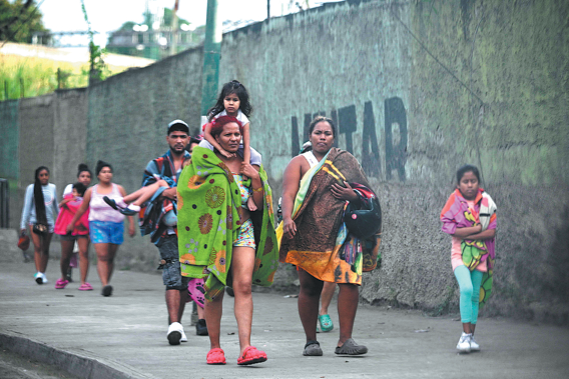China's National Defense in the New Era
China Daily | Updated: 2019-07-25 08:09
III. Fulfilling the Missions and Tasks of China's Armed Forces in the New Era
In the new era, to meet the strategic demands of national security and development, China's armed forces firmly implement the missions and tasks entrusted by the CPC and the people. They endeavor to provide strategic support for consolidating the leadership of the CPC and the socialist system, safeguarding national sovereignty, unity and territorial integrity, protecting China's overseas interests, and promoting world peace and development.
Safeguarding National Territorial Sovereignty and Maritime Rights and Interests
China has a land border of more than 22,000 km and a coastline of over 18,000 km, China surpasses most of countries in the number of neighboring countries, the length of land border, and the complexity of maritime security. Therefore, it is a daunting task for China to safeguard its territorial sovereignty, maritime rights and interests, and national unity.
China's armed forces maintain a rigorous guard against encroachment, infiltration, sabotage or harassment so as to safeguard border security and stability. China has signed border cooperation agreements with 9 neighboring countries and set up border meeting mechanisms with 12 countries. China's armed forces have established mechanisms for exchanges with neighboring countries at three levels: national defense ministry, Theater Commands (TCs), and border troops. They conduct regular friendly mutual visits, working meetings, joint patrols and joint exercises targeting transnational crime with their foreign counterparts. They work together with Kazakhstan, Kyrgyzstan, Russia and Tajikistan to implement the border disarmament treaty. They strive to promote stability and security along the border with India, and take effective measures to create favorable conditions for the peaceful resolution of the Donglang (Doklam) standoff. They enhance control along the border with Afghanistan to guard against the infiltration of terrorists. They strengthen security management along the border with Myanmar, so as to secure stability and public safety in the border areas. Since 2012, China's border troops have completed over 3,300 joint patrols and conducted over 8,100 border meetings with their foreign counterparts. They have cleared mines from 58 square kilometers of land, closed 25 square kilometers of landmine area, and disposed of 170,000 explosive devices such as landmines along the borders with Vietnam and Myanmar.
China's armed forces defend important waters, islands and reefs in the East China Sea, the South China Sea and the Yellow Sea, acquire full situation awareness of adjacent waters, conduct joint rights protection and law enforcement operations, properly handle maritime and air situations, and resolutely respond to security threats, infringements and provocations on the sea. Since 2012, China's armed forces have deployed vessels on over 4,600 maritime security patrols and 72,000 rights protection and law enforcement operations, and safeguarded maritime peace, stability and order.
China's armed forces conduct air defense, reconnaissance and early warning, monitor China's territorial air and peripheral air space, carry out alert patrols and combat takeoff, and effectively respond to emergencies and threats to maintain order and security in the air.
Aiming at safeguarding national unity, China's armed forces strengthen military preparedness with emphasis on the sea. By sailing ships and flying aircraft around Taiwan, the armed forces send a stern warning to the "Taiwan independence" separatist forces.
Maintaining Combat Readiness
Maintaining combat readiness is an important assurance of effective response to security threats and fulfillment of tasks. The Central Military Commission (CMC) and the TCs' joint operations commands perform combat readiness duties strictly, and conduct regular inspections and drills to ensure combat readiness at all times. Consistent efforts are made to improve the capabilities of joint operations command to exercise reliable and efficient command over emergency responses, and to effectively accomplish urgent, tough and dangerous tasks. In 2018, the CMC conducted surprise inspections throughout the armed forces and organized readiness drills for the units, covering 21 provinces, autonomous regions and municipalities directly under the central government, and parts of the East China Sea and South China Sea.
The PLA and the People's Armed Police Force (PAP) give greater priority to combat readiness. Efforts are made to strictly act on relevant regulations and procedures, fulfill readiness duties, conduct targeted exercises and training, and maintain standardized order, with a view to staying ready to act when required and effectively carrying out readiness (combat) duties.
Carrying Out Military Training in Real Combat Conditions
Military training is the basic practice of the armed forces in peacetime. China's armed forces put military training in an important position and take combat effectiveness as the sole and fundamental criterion. In order to enhance realistic training, they optimize the policy framework and criteria in this respect, establish and improve the relevant supervision system, conduct supervision on military training for emergencies and combat across the services, implement the responsibility system for training and readiness, and organize extensive contests and competitions to encourage officers and soldiers to step up military training.
Military training in real combat conditions across the armed forces is in full swing. Since 2012, China's armed forces have carried out extensive mission-oriented training tailored to the specific needs of different strategic directions and exercises of all services and arms, including 80 joint exercises at and above brigade/division level.
The TCs have strengthened their leading role in joint training and organized serial joint exercises codenamed the East, the South, the West, the North and the Central, to improve joint combat capabilities.
The PLA Army (PLAA) has organized training competitions and conducted live exercises codenamed Stride and Firepower. The PLA Navy (PLAN) has extended training to the far seas and deployed the aircraft carrier task group for its first far seas combat exercise in the West Pacific. It has organized naval parades in the South China Sea and the waters and airspace near Qingdao, and conducted a series of live force-on-force exercises codenamed Mobility and systematic all-elements exercises. The PLA Air Force (PLAAF) has strengthened systematic and all-airspace training based on operational plans. It has conducted combat patrols in the South China Sea and security patrols in the East China Sea, and operated in the West Pacific. It has completed a series of regular system-vs.-system exercises such as Red Sword. The PLA Rocket Force (PLARF) has organized force-on-force evaluation-oriented training and training based on operational plans at brigade and regiment levels, strengthened training for joint strikes, and completed regular exercises such as Heavenly Sword. The PLA Strategic Support Force (PLASSF) has made active efforts to integrate into the joint operations systems. It has carried out confrontational training in new domains and trained for emergencies and combats. The PLA Joint Logistic Support Force (PLAJLSF) has striven to align itself with the joint operations systems, and conducted exercises such as Joint Logistics Mission 2018. The PAP has developed to meet the requirements of nationwide coverage, effective connectivity, all-area response and integrated functions, and conducted a series of exercises including Guard.
Safeguarding Interests in Major Security Fields
Nuclear capability is the strategic cornerstone to safeguarding national sovereignty and security. China's armed forces strengthen the safety management of nuclear weapons and facilities, maintain the appropriate level of readiness and enhance strategic deterrence capability to protect national strategic security and maintain international strategic stability.
Outer space is a critical domain in international strategic competition. Outer space security provides strategic assurance for national and social development. In the interest of the peaceful use of outer space, China actively participates in international space cooperation, develops relevant technologies and capabilities, advances holistic management of space-based information resources, strengthens space situation awareness, safeguards space assets, and enhances the capacity to safely enter, exit and openly use outer space.
Cyberspace is a key area for national security, economic growth and social development. Cyber security remains a global challenge and poses a severe threat to China. China's armed forces accelerate the building of their cyberspace capabilities, develop cyber security and defense means, and build cyber defense capabilities consistent with China's international standing and its status as a major cyber country. They reinforce national cyber border defense, and promptly detect and counter network intrusions. They safeguard information and cyber security, and resolutely maintain national cyber sovereignty, information security and social stability.
Countering Terrorism and Maintaining Stability
China firmly opposes all forms of terrorism and extremism. As mandated by law, China's armed forces participate in operations for maintaining social order, prevent and combat violence and terrorism, safeguard political security and social stability, and secure the public's right to live and work in peace.
The PAP fulfills missions such as guarding key targets, on-site security protection, setting check points on key passages, and armed urban patrols. In accordance with the law, the PAP supports civil authorities in law enforcement operations to combat criminal gangs and terrorist activities, actively participates in the maintenance of public order, and prevents and responds to potential threats to China's political security and social order, thus making a significant contribution to the Peaceful China initiative. Since 2012, the PAP has deployed large numbers of troops annually in security duties, counter-terrorism, emergency response, and maritime rights protection and law enforcement. It has completed around 10,000 security assignments during major events such as the G20 Summit, the APEC Economic Leaders' Meeting, the Belt and Road Forum for International Cooperation, the BRICS Leaders Meeting, and the SCO Qingdao Summit, and participated in the response to 671 hostage situations, incidents of severe violence, and terrorist attacks. Since 2014, the PAP has assisted the government of Xinjiang Uygur Autonomous Region in taking out 1,588 violent terrorist gangs and capturing 12,995 terrorists.
The PLA supports the civil authorities in maintaining social stability, provides security for major events, and responds to emergencies in accordance with the law. It is mainly tasked with missions such as counter-terrorism, NBCE detection and test, medical relief, and transport support. It disposes of potential safety hazards in the waters and protects security in the air over and around major event venues.
Protecting China's Overseas Interests
Overseas interests are a crucial part of China's national interests. One of the missions of China's armed forces is to effectively protect the security and legitimate rights and interests of overseas Chinese people, organizations and institutions.
The PLA actively promotes international security and military cooperation and refines relevant mechanisms for protecting China's overseas interests. To address deficiencies in overseas operations and support, it builds far seas forces, develops overseas logistical facilities, and enhances capabilities in accomplishing diversified military tasks. The PLA conducts vessel protection operations, maintains the security of strategic SLOCs, and carries out overseas evacuation and maritime rights protection operations.
In August 2017, the PLA Djibouti Support Base entered service. The base has provided equipment for the maintenance of four escort task groups, offered medical services for over 100 officers and sailors on board, conducted joint medical exercises with foreign militaries, and donated over 600 teaching aids to local schools.
When the security situation in Yemen deteriorated in March 2015, a PLAN escort task group sailed to the Gulf of Aden, berthed for the first time directly in an engagement area, and evacuated 621 Chinese citizens and 279 foreign citizens from 15 countries including Pakistan, Ethiopia, Singapore, Italy, Poland, Germany, Canada, the UK, India and Japan.
Participating in Disaster Rescue and Relief
Participating in national development and protecting the public's rights to work in peace are the responsibilities of China's armed forces mandated by the Constitution of the PRC. As stipulated in the Regulations on Participation in Emergency Rescue and Disaster Relief by China's Armed Forces, China's armed forces are mainly tasked with rescuing, transferring and evacuating trapped populations; ensuring the security of important targets; salvaging and transporting important materials; conducting specialized operations such as restoration of transport facilities including roads, bridges and tunnels, maritime search and rescue, NBC rescue, epidemic control and medical relief; eliminating or controlling other major threats, dangerous situations and disasters; and supporting civil authorities in post-disaster reconstruction.
Since 2012, the PLA and the PAP have deployed 950,000 soldiers, 1.41 million militia, 190,000 vehicles and items of equipment, and sortied 26,000 vessels and 820 aircraft in emergency response and disaster relief. They have participated in rescue and relief efforts such as the earthquake in Ludian County of Yunnan Province, the rainstorm and flood in the middle and lower reaches of the Yangtze River, and the removal of the barrier lake in the Yarlung Zangbo River. They have assisted local governments to rescue and transfer over 5 million people, treated over 210,000 patients, transported over 360,000 tons of goods, and reinforced over 3,600 km of levees. In 2017, the PLA Macao Garrison sent 2,631 soldiers and over 160 vehicles to assist the government of Macao Special Administrative Region in its relief efforts in the wake of Typhoon Hato.
























